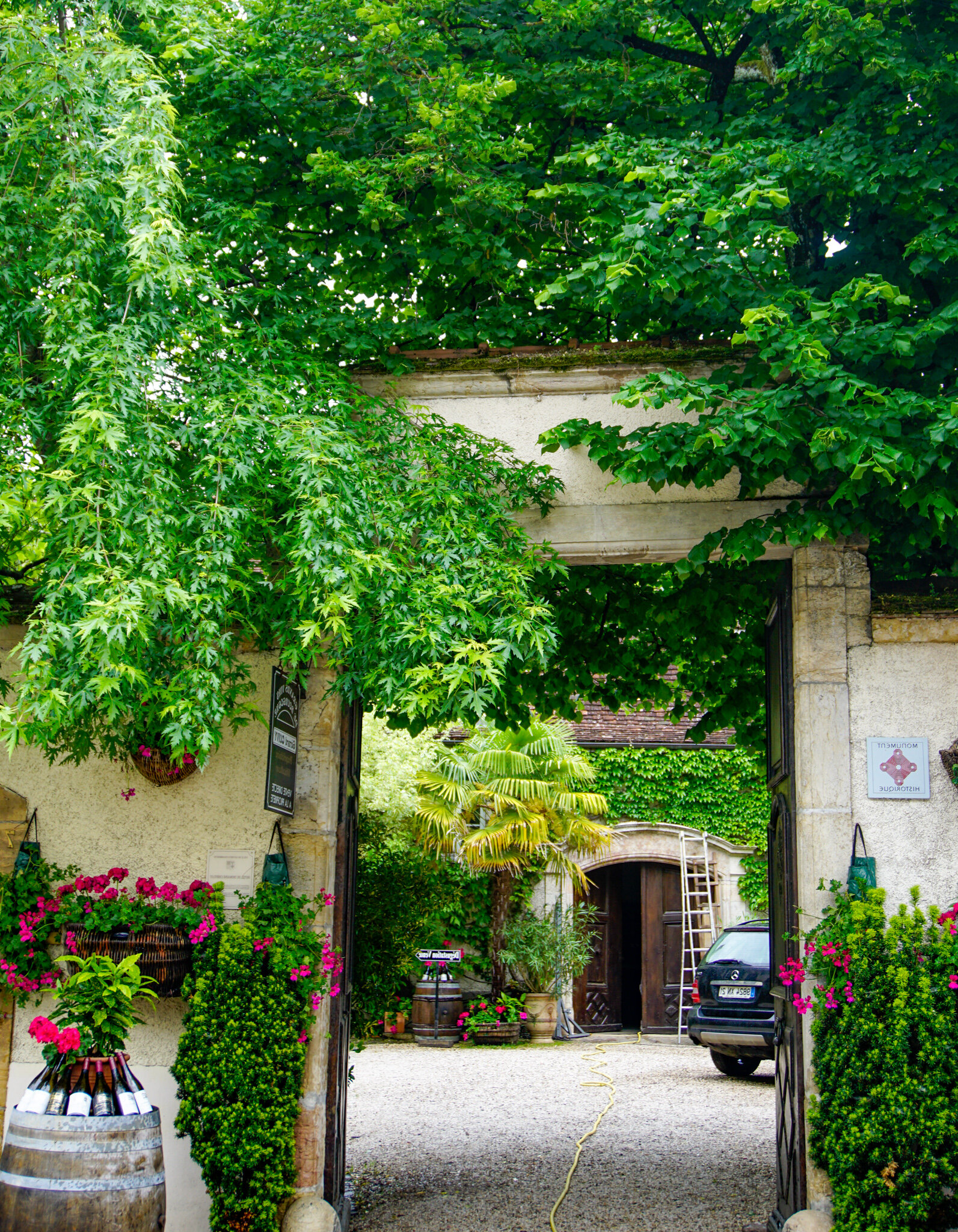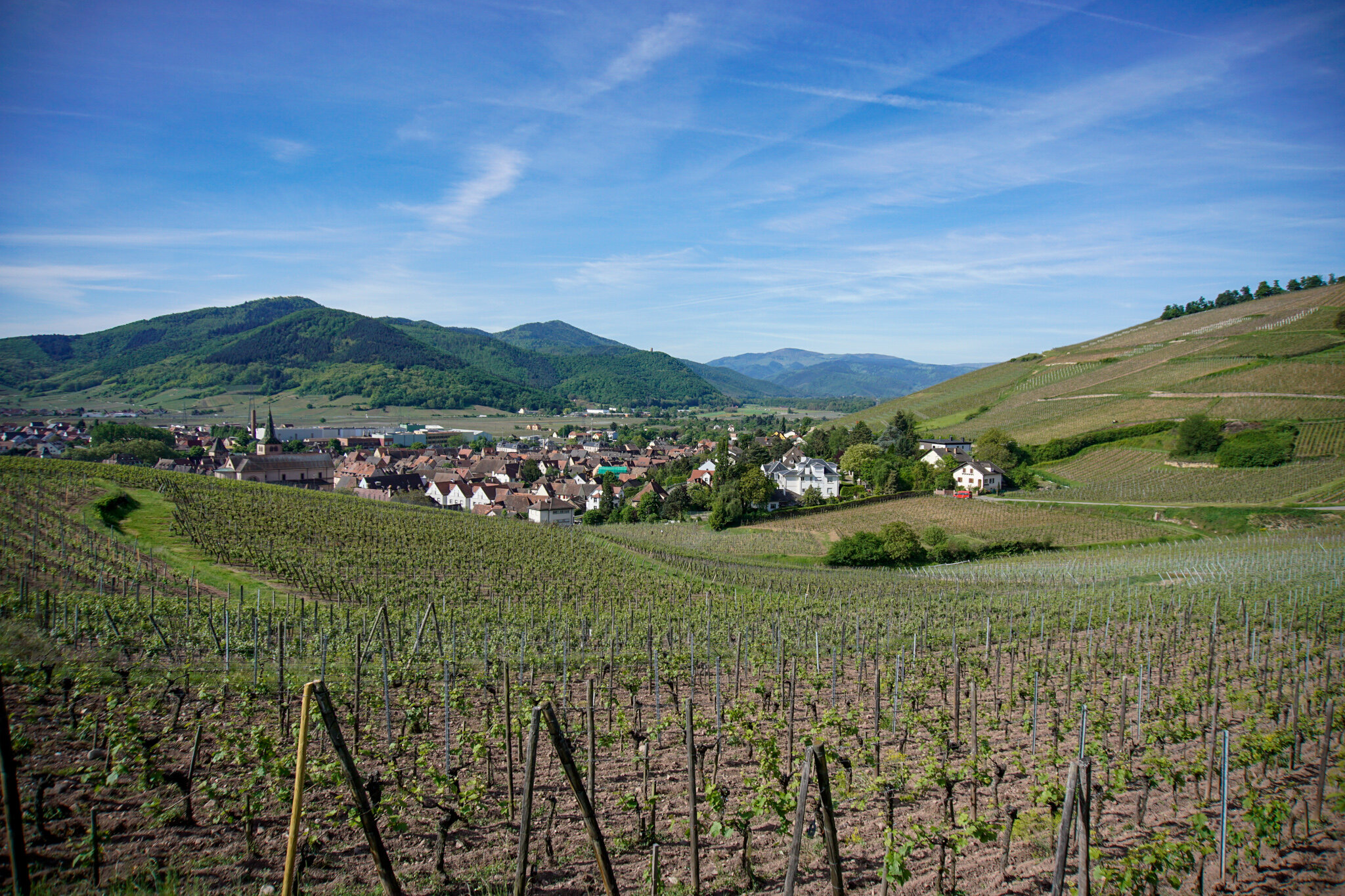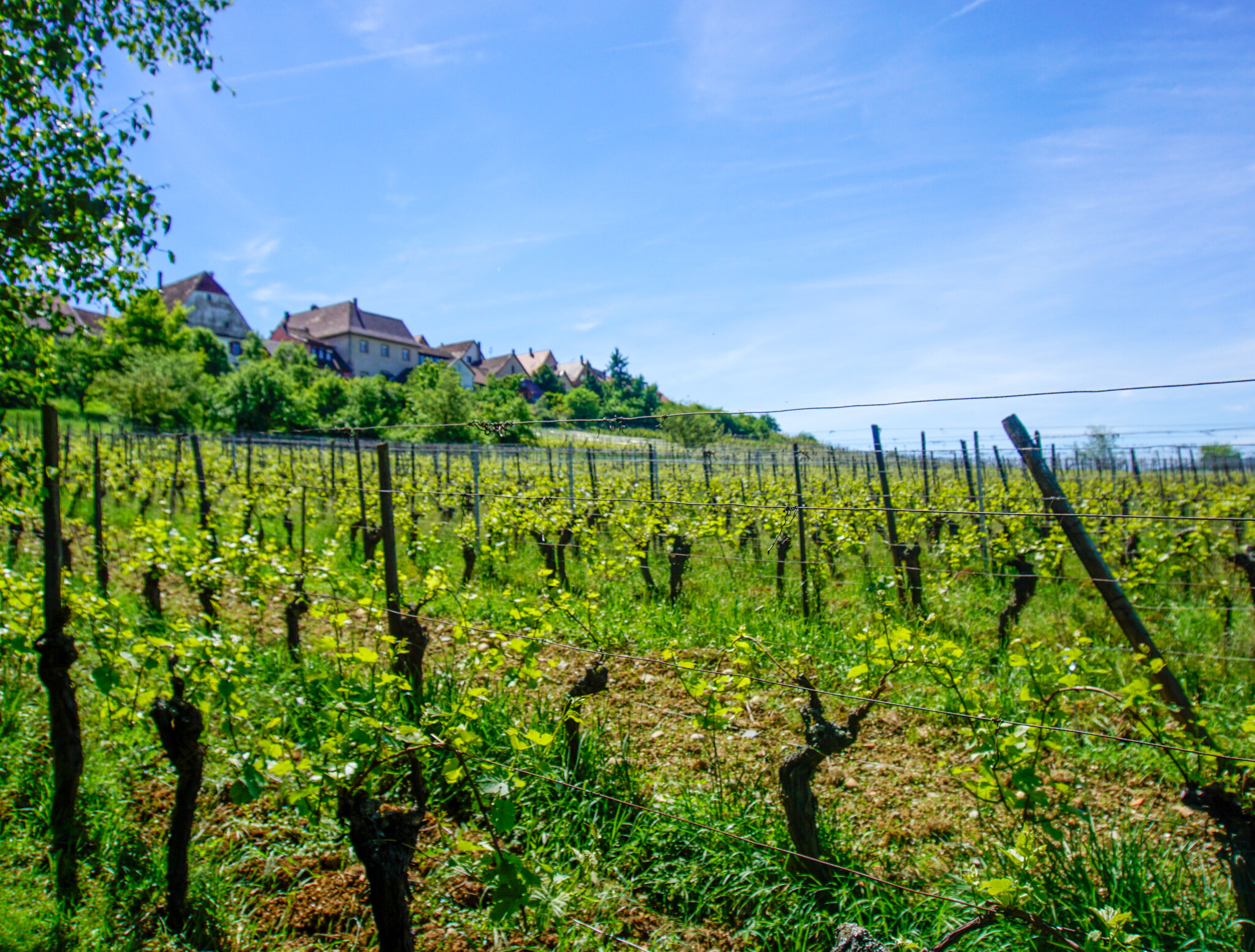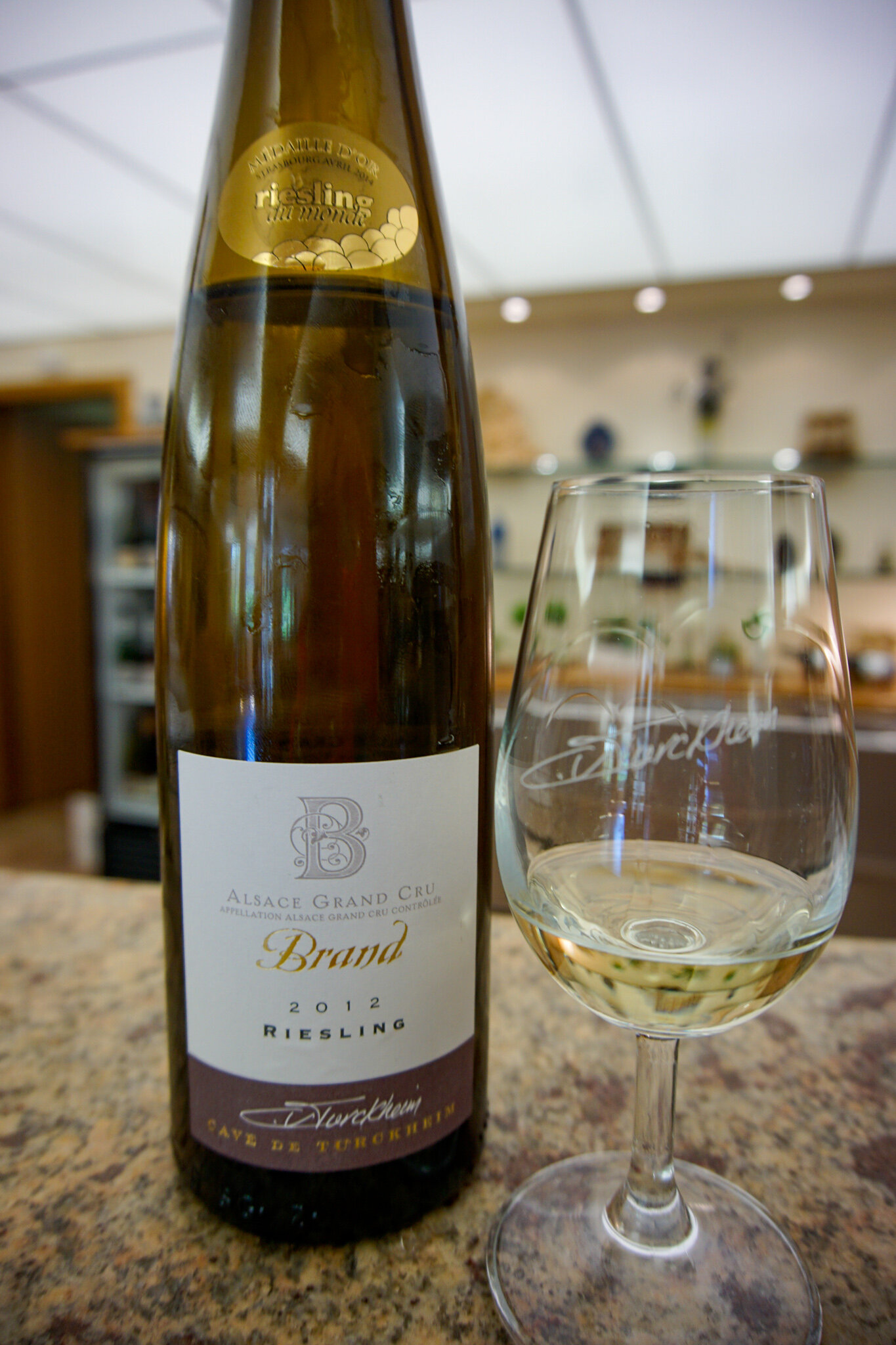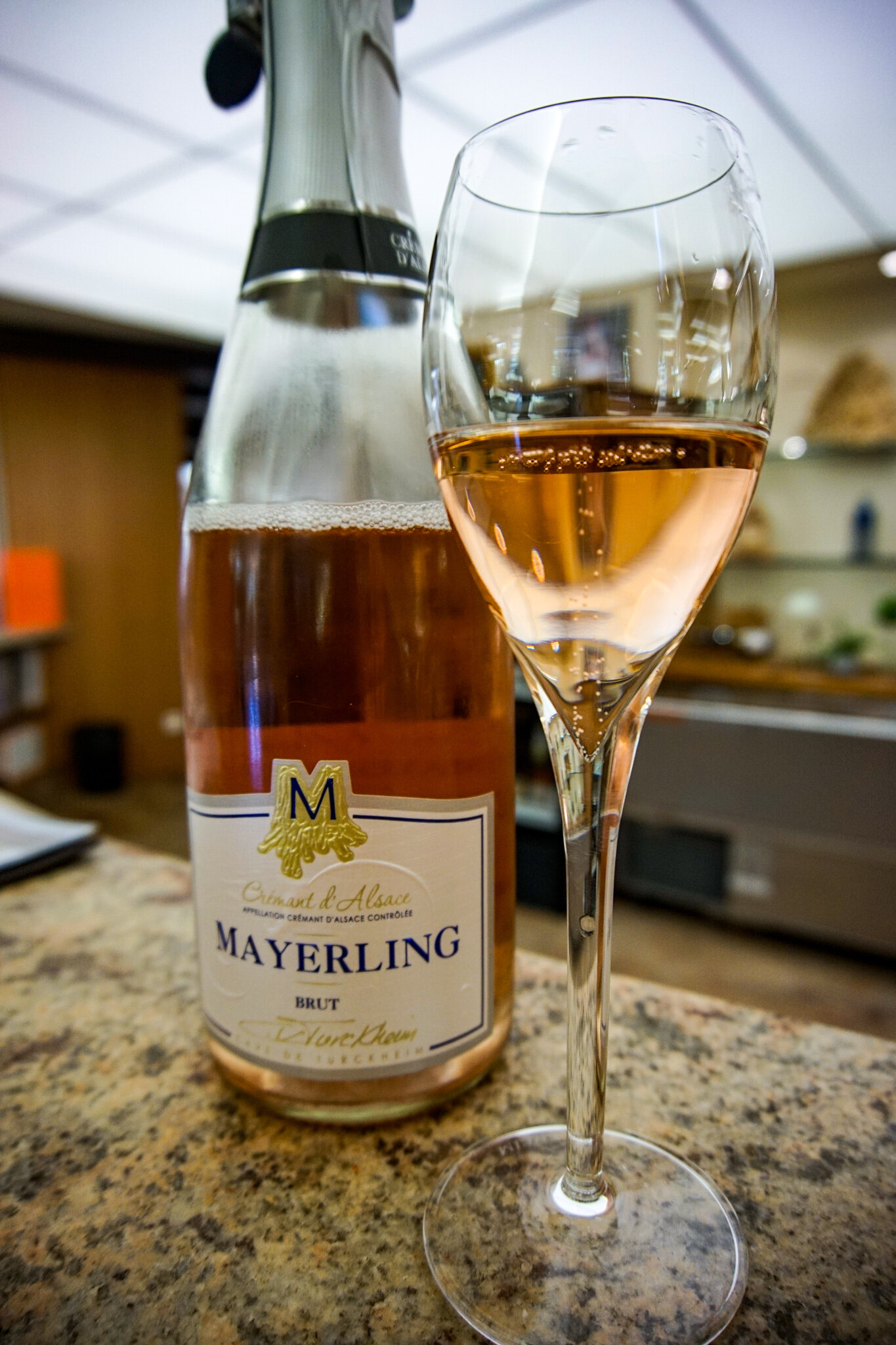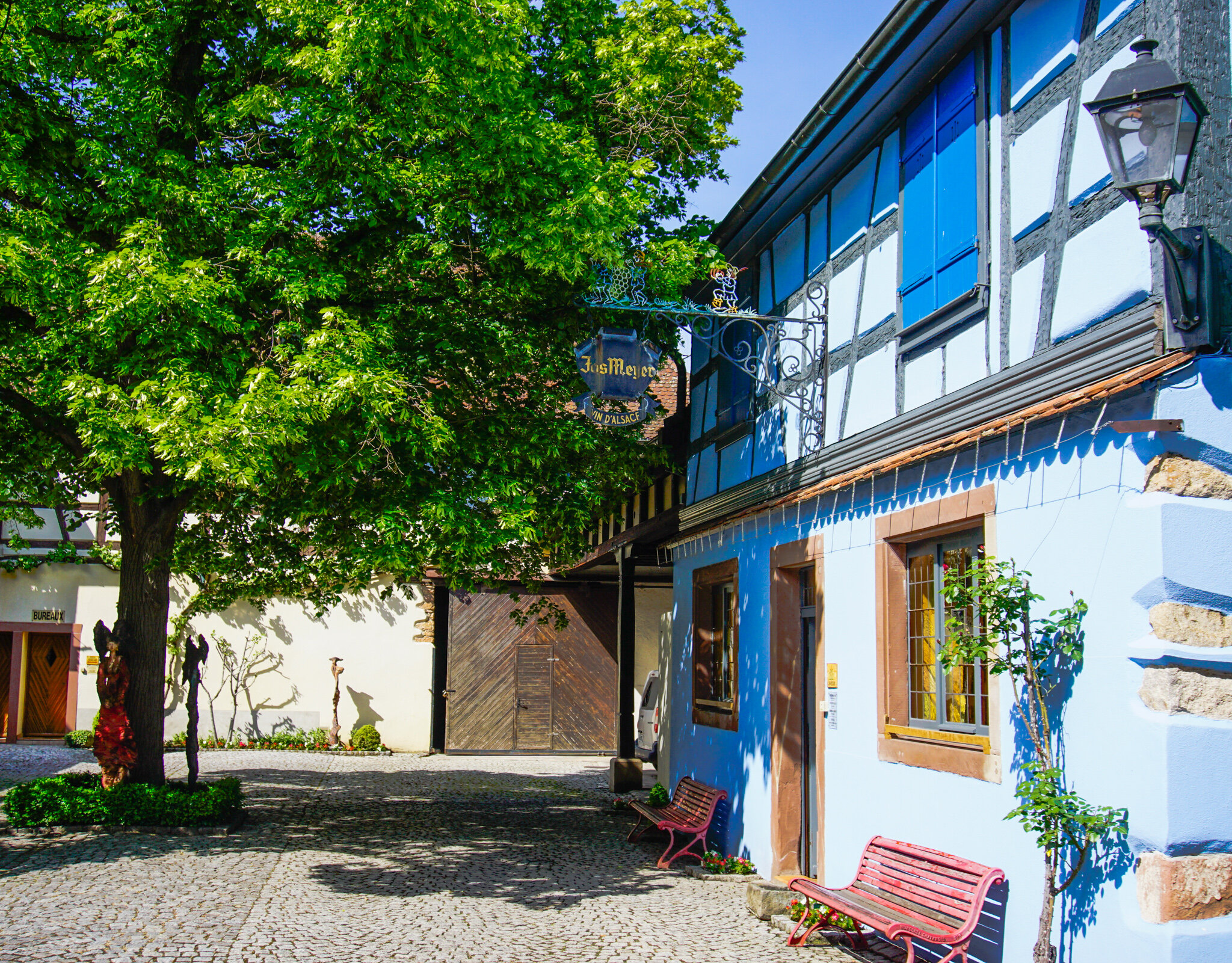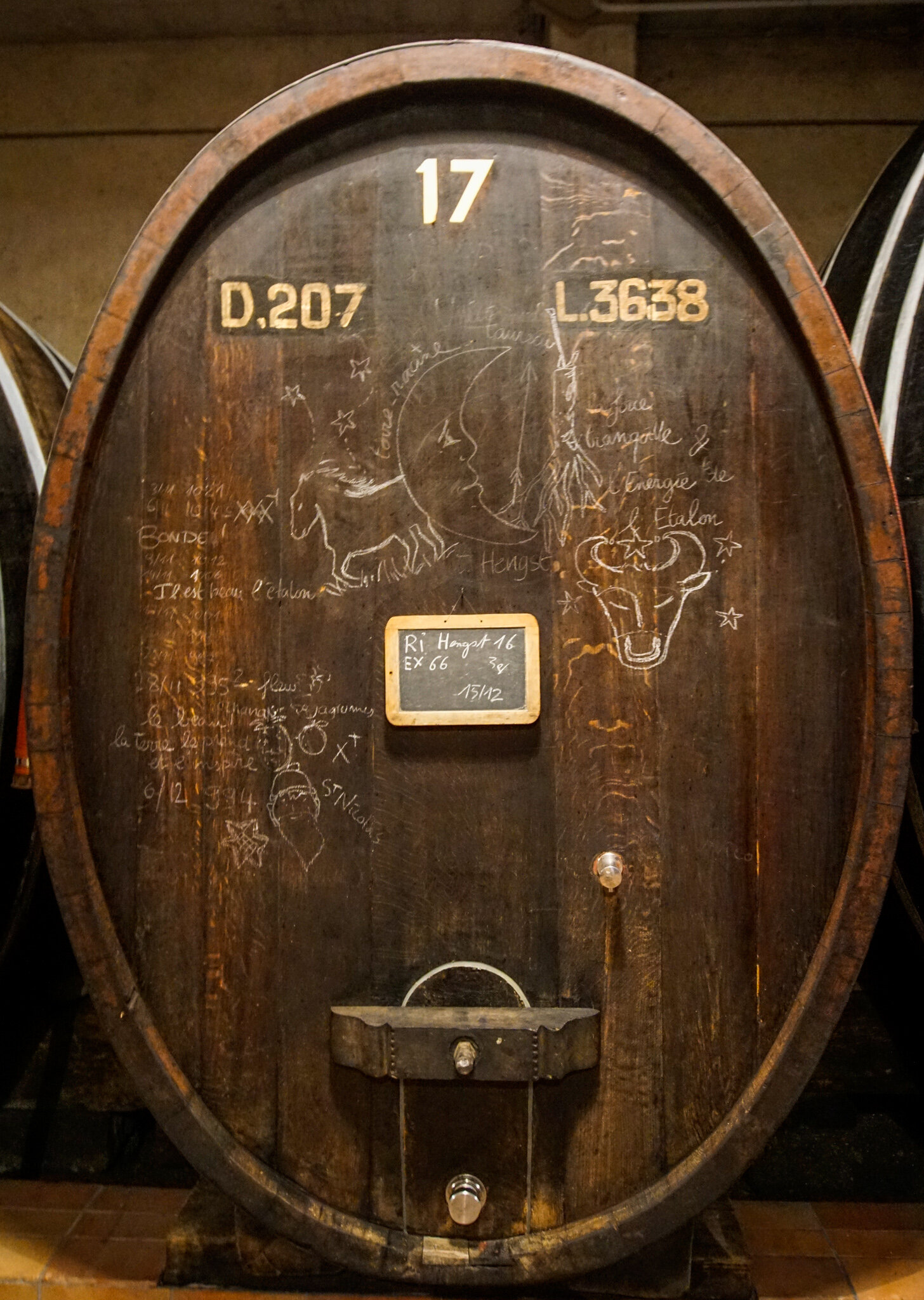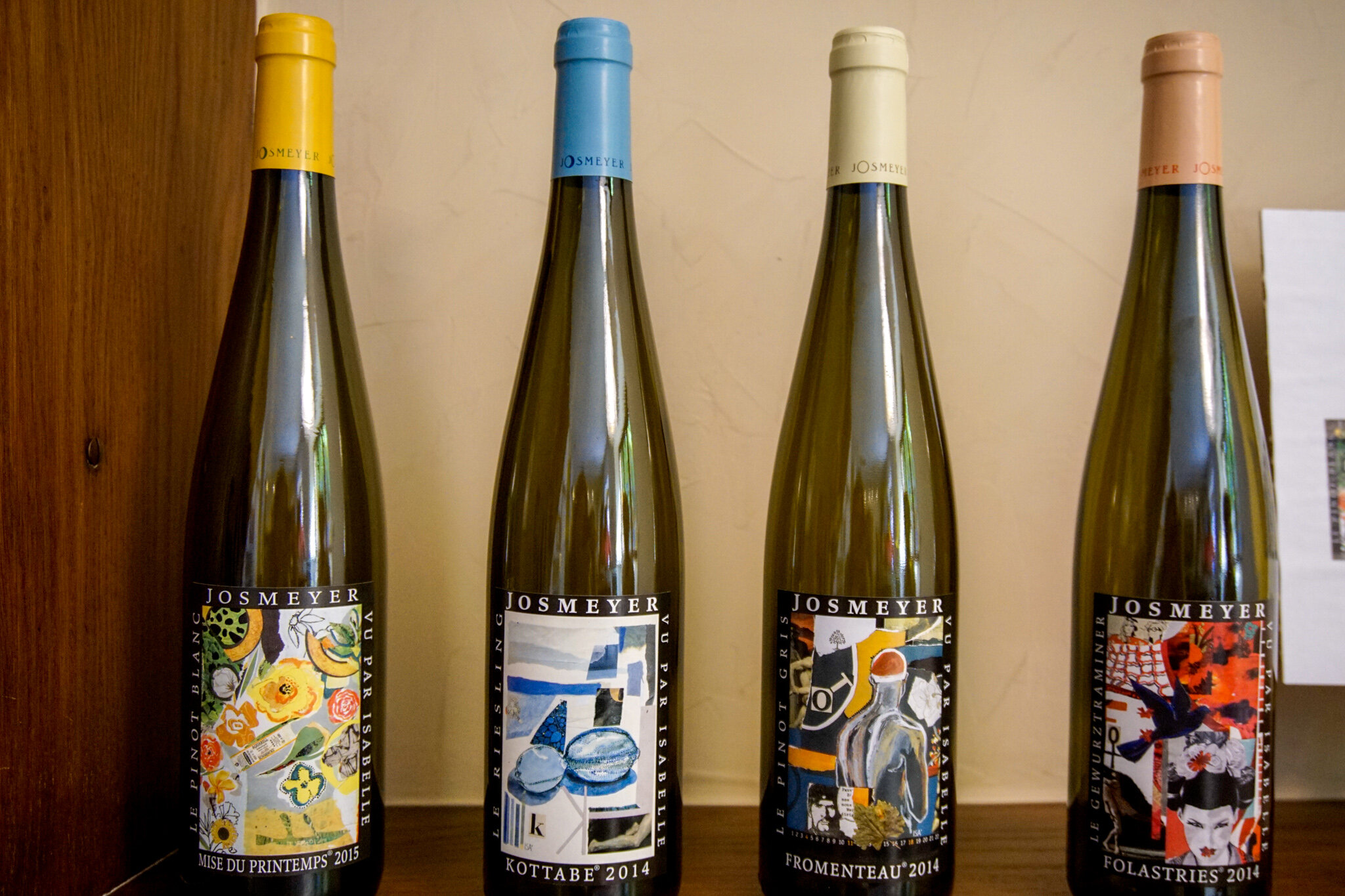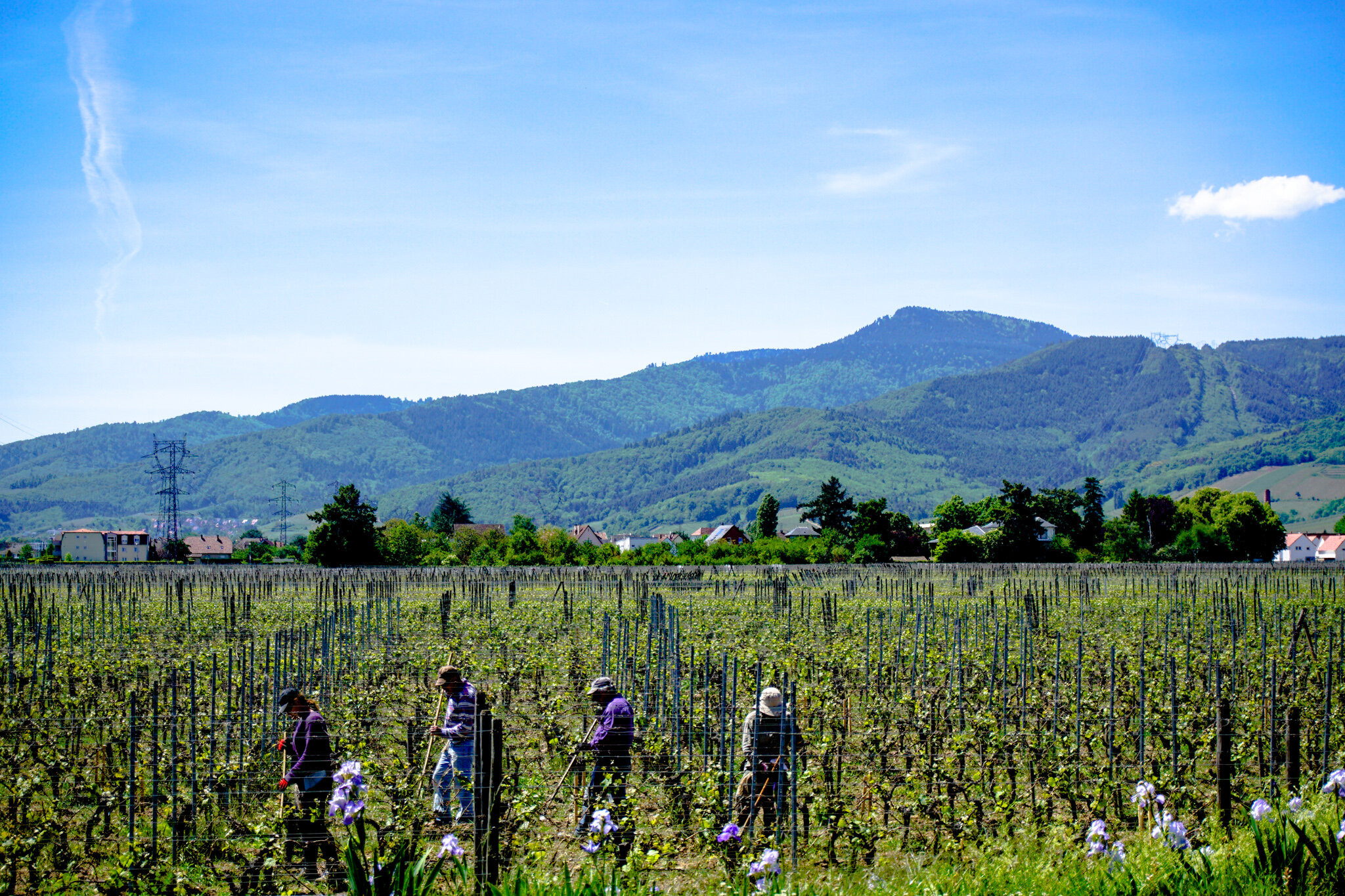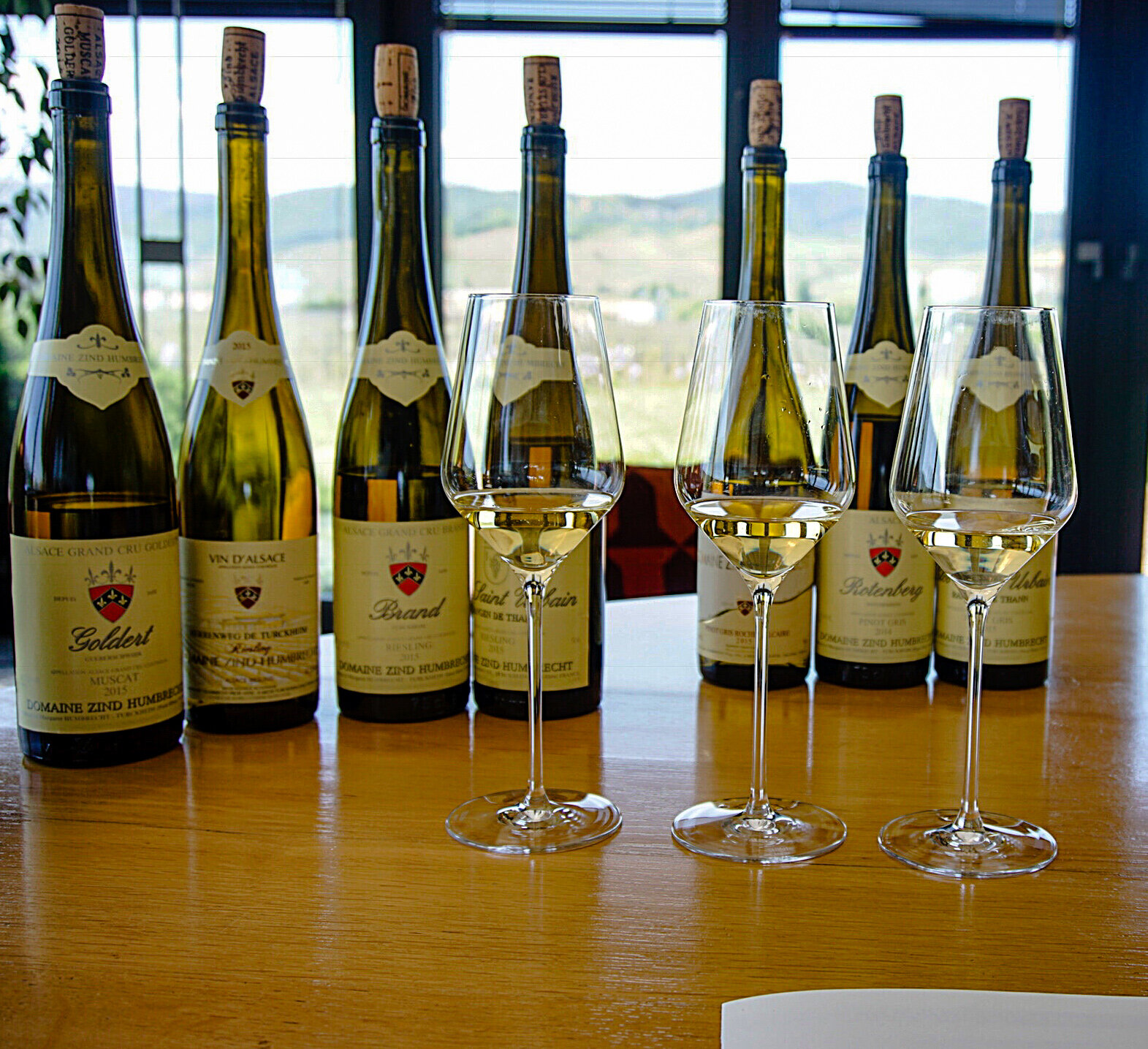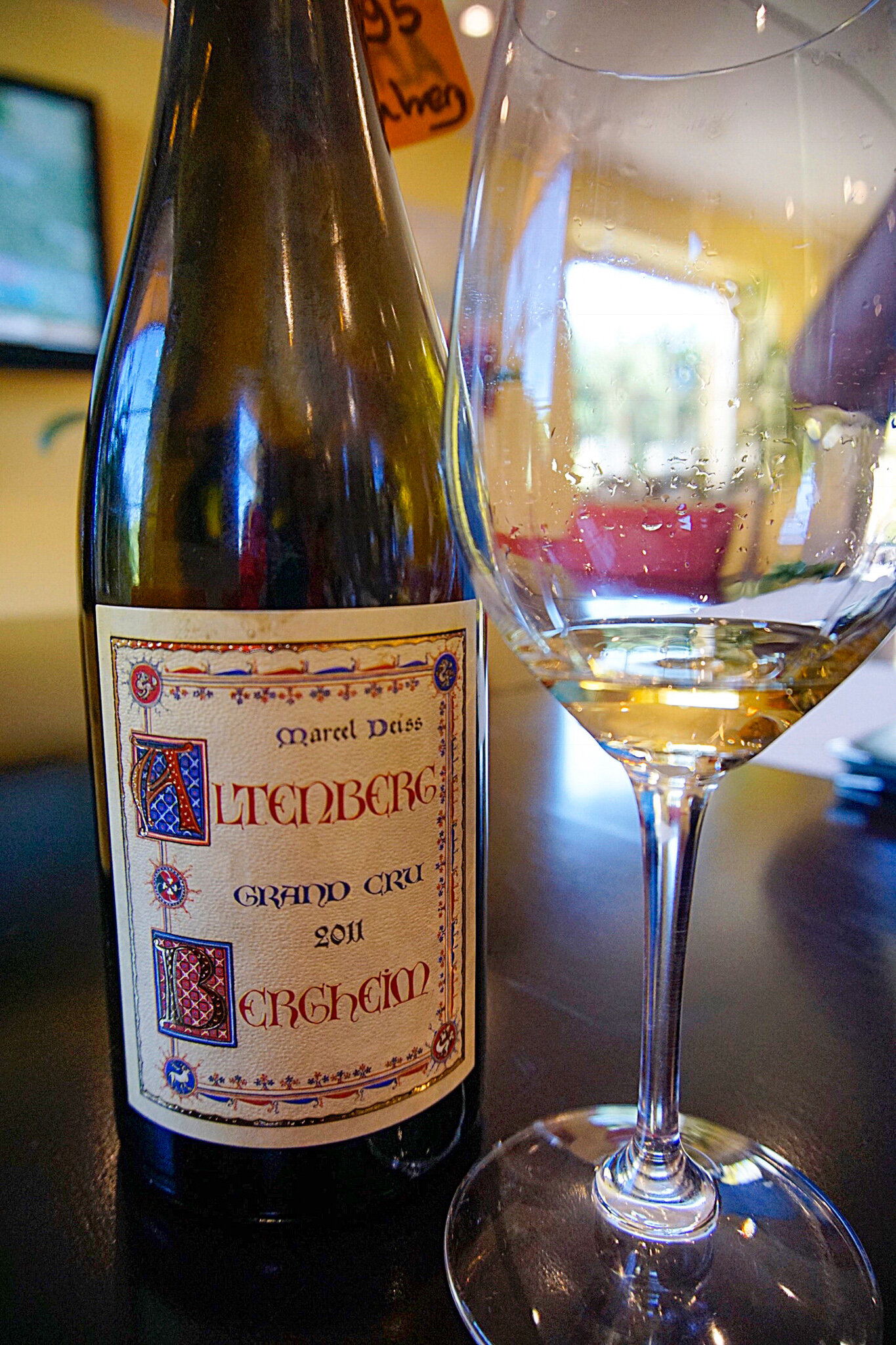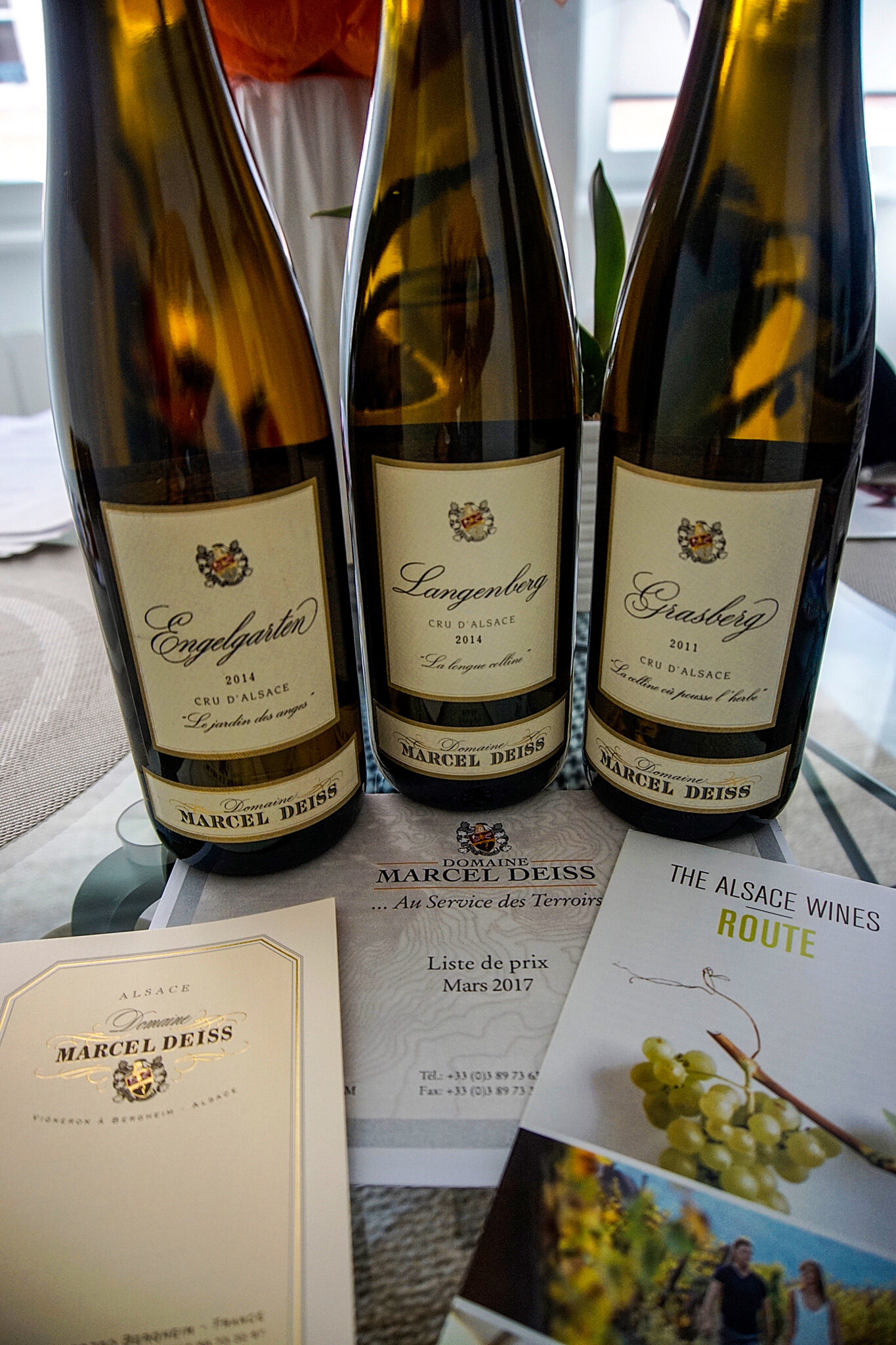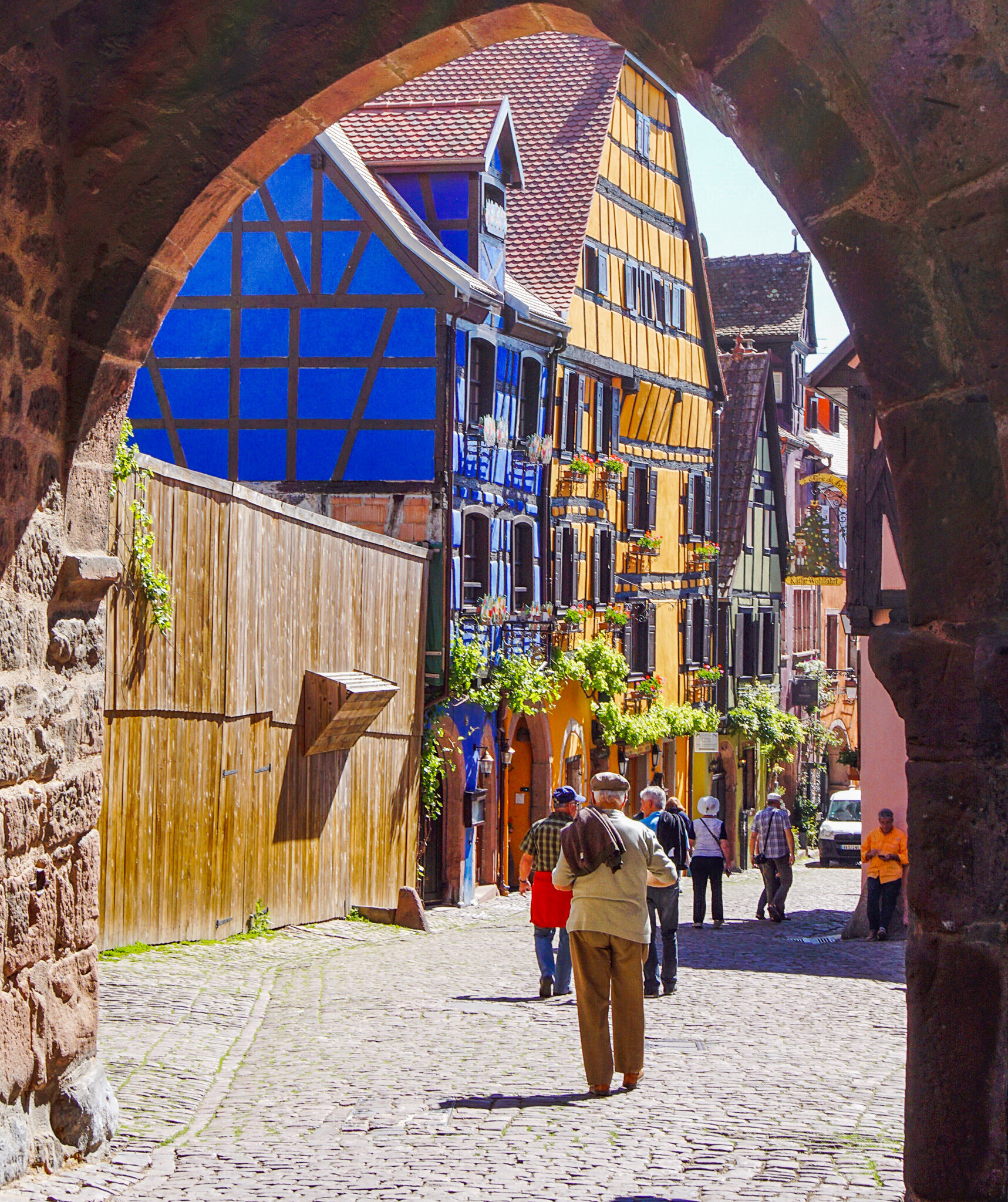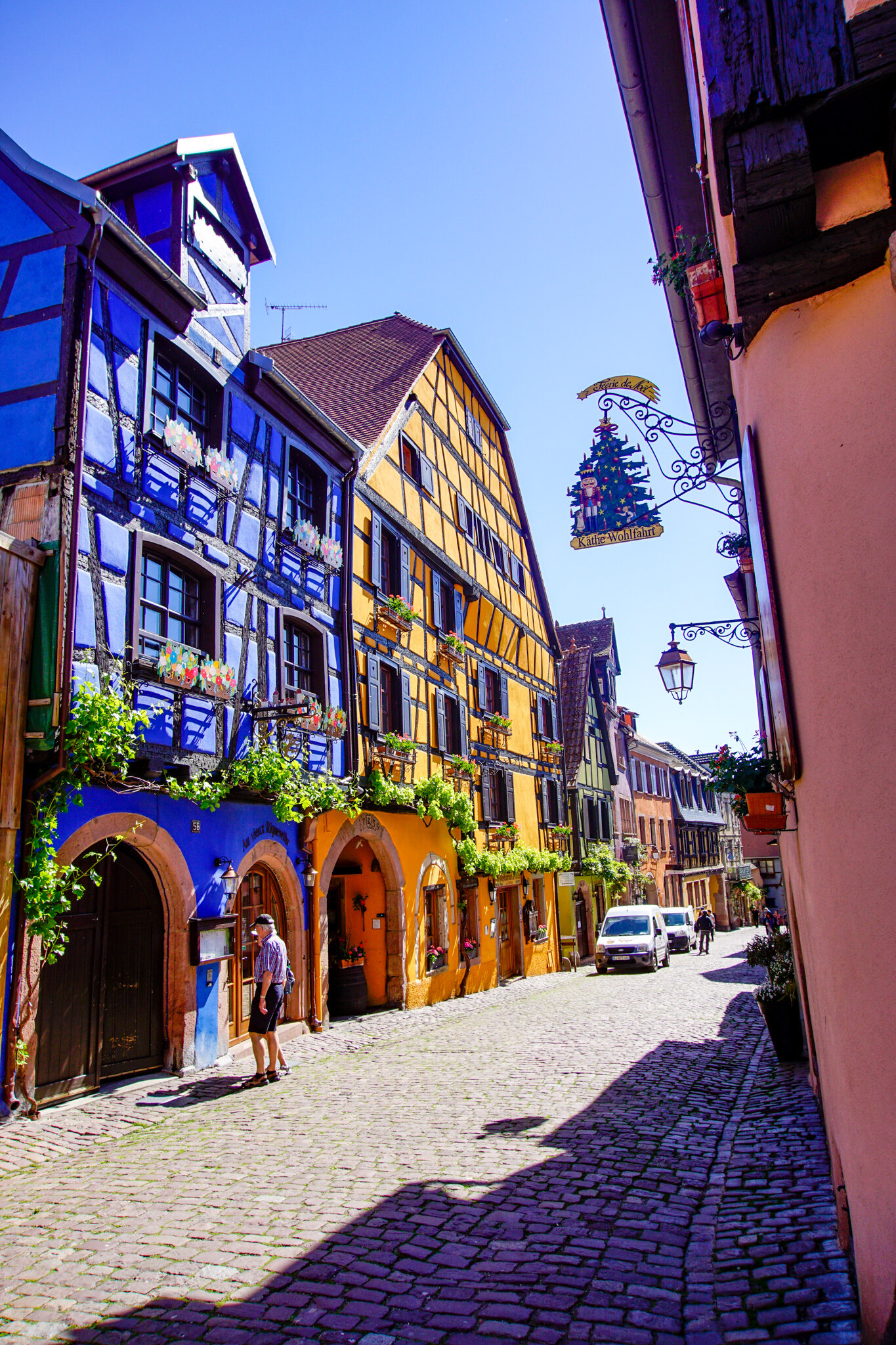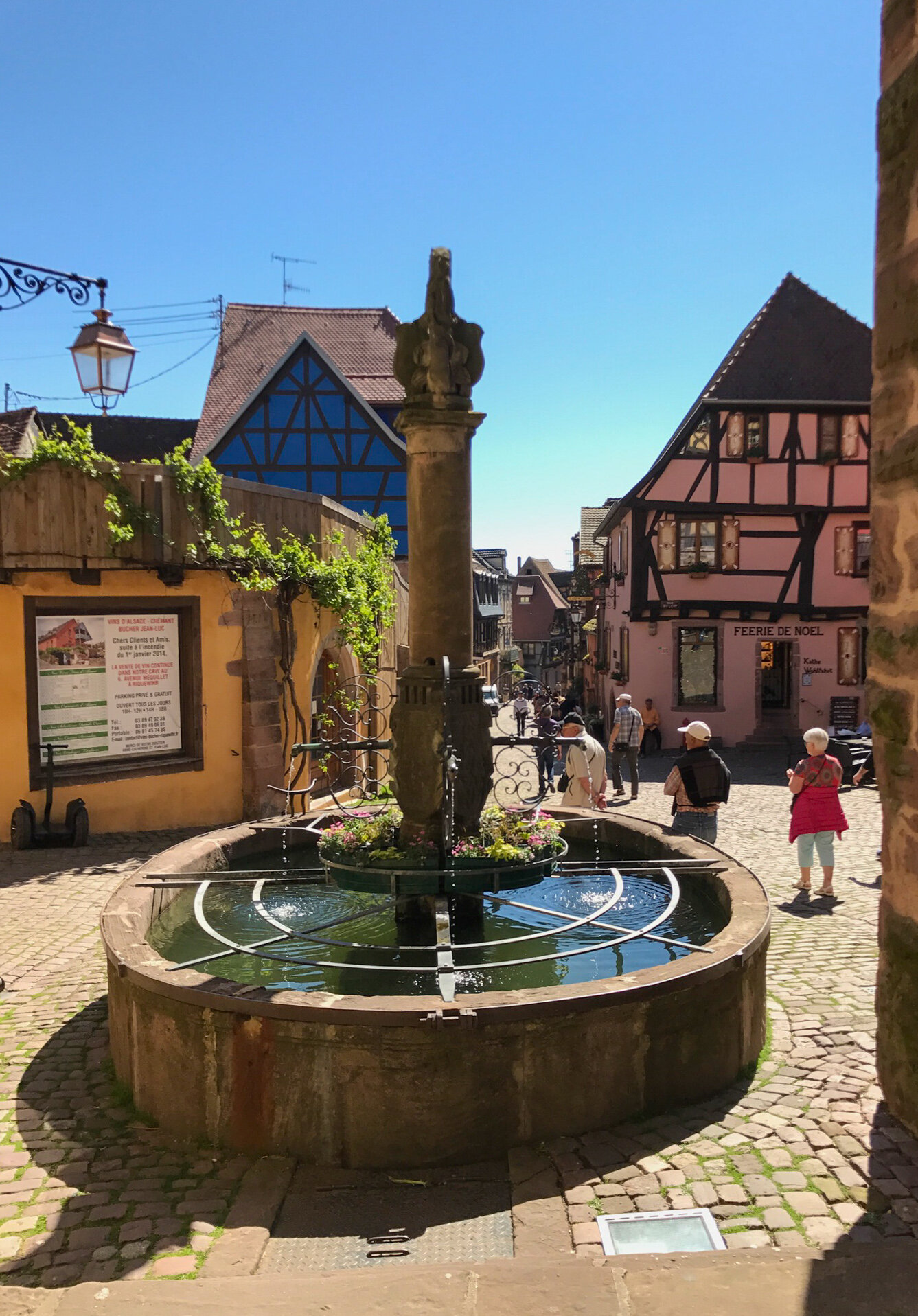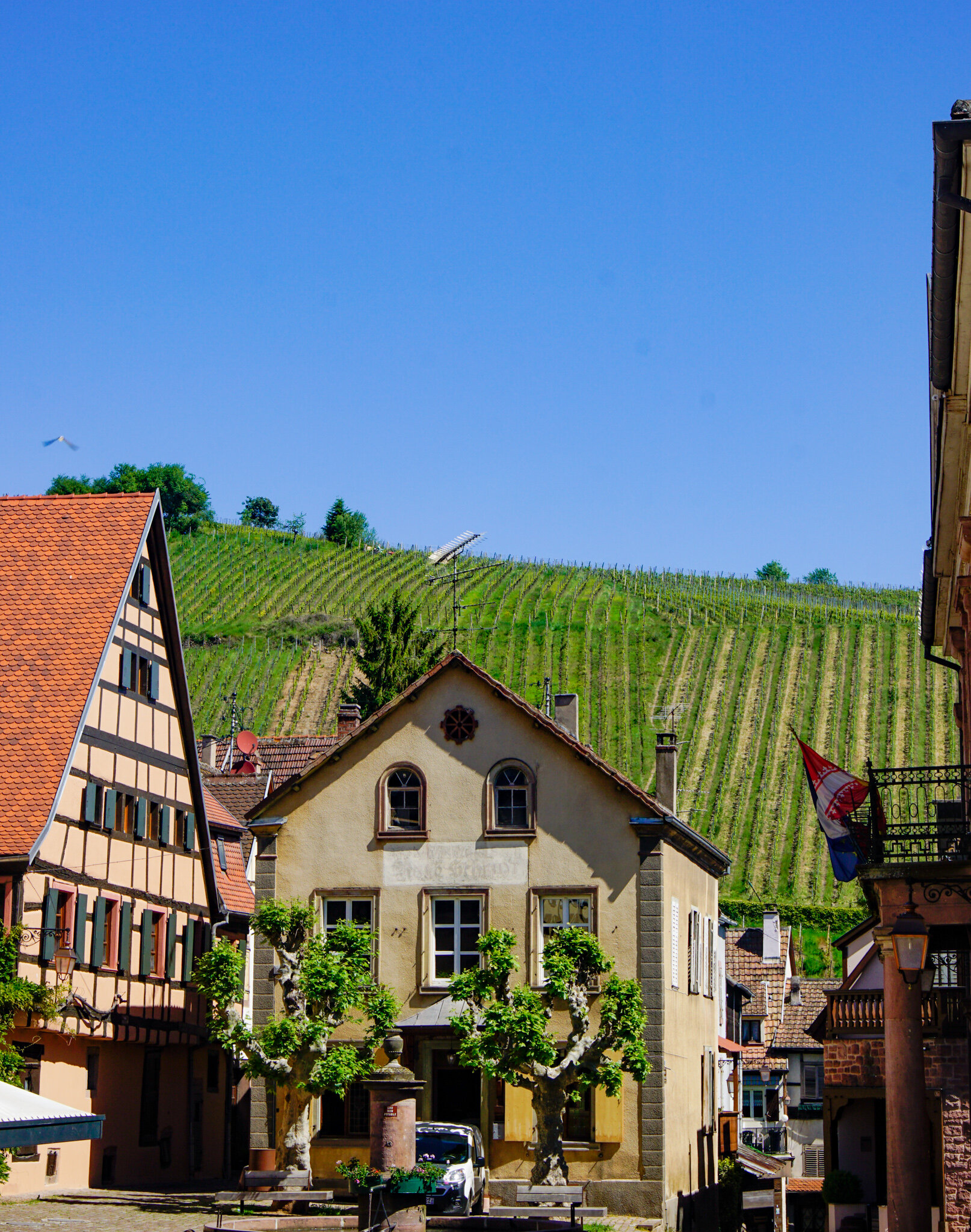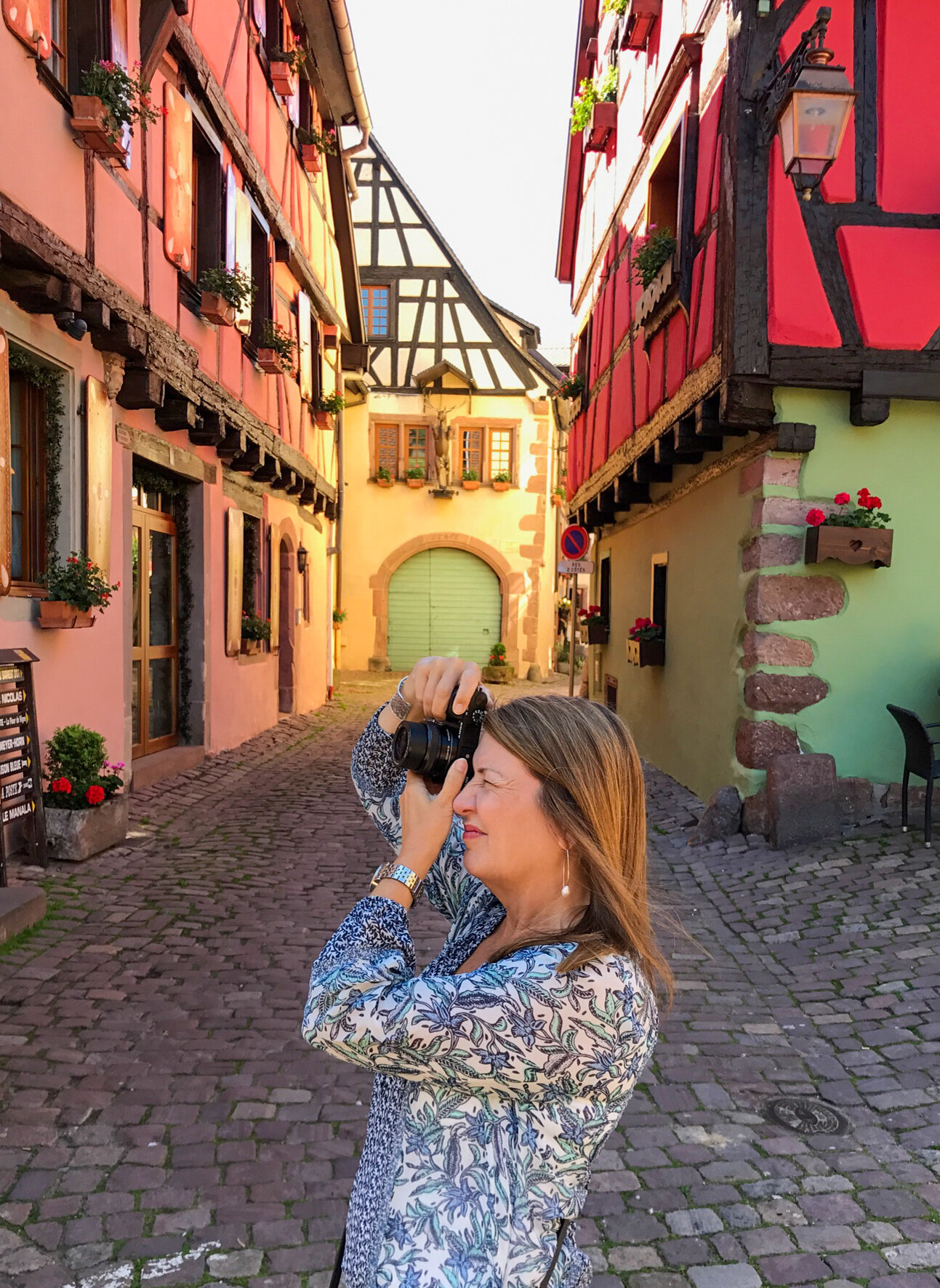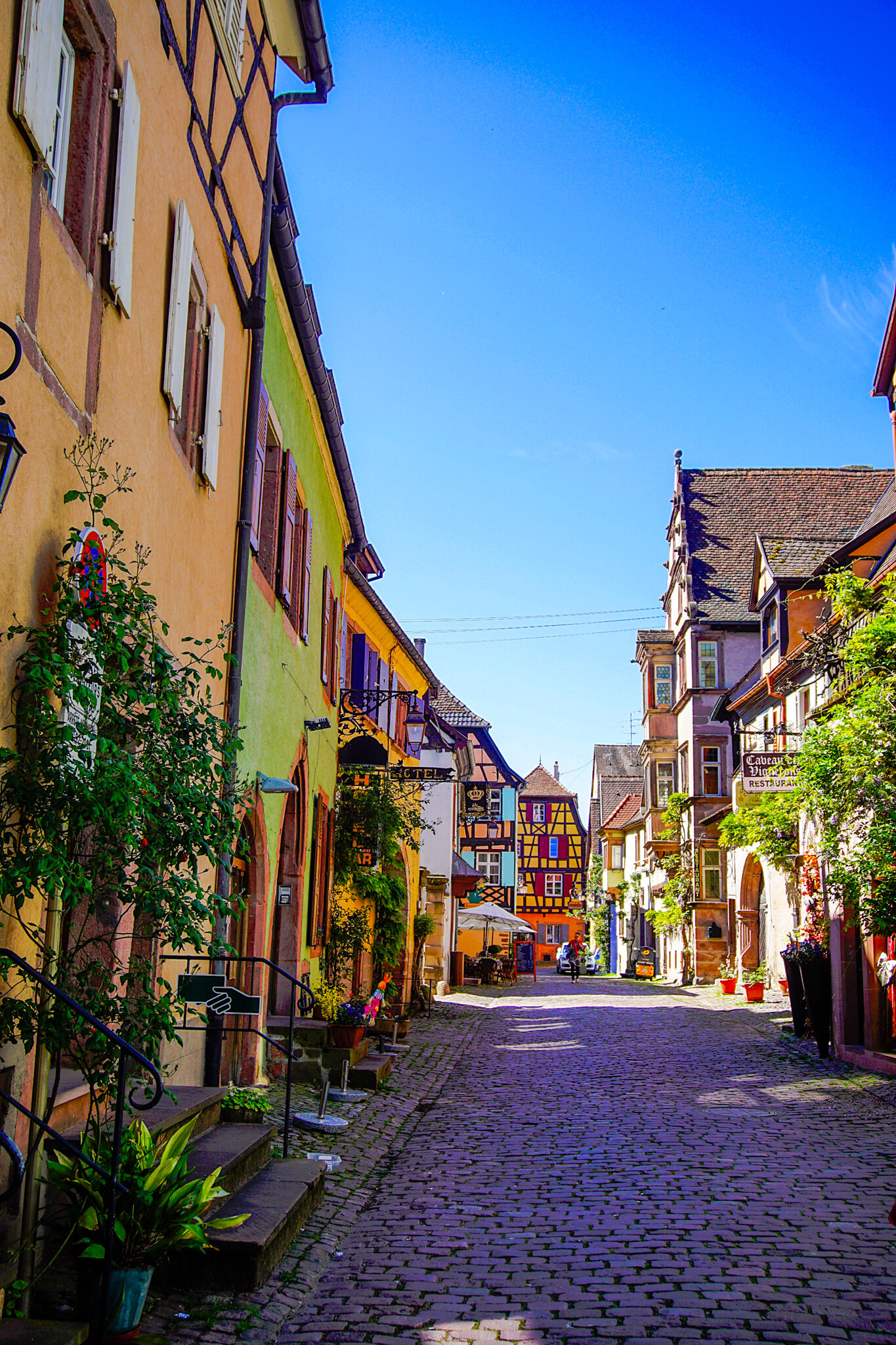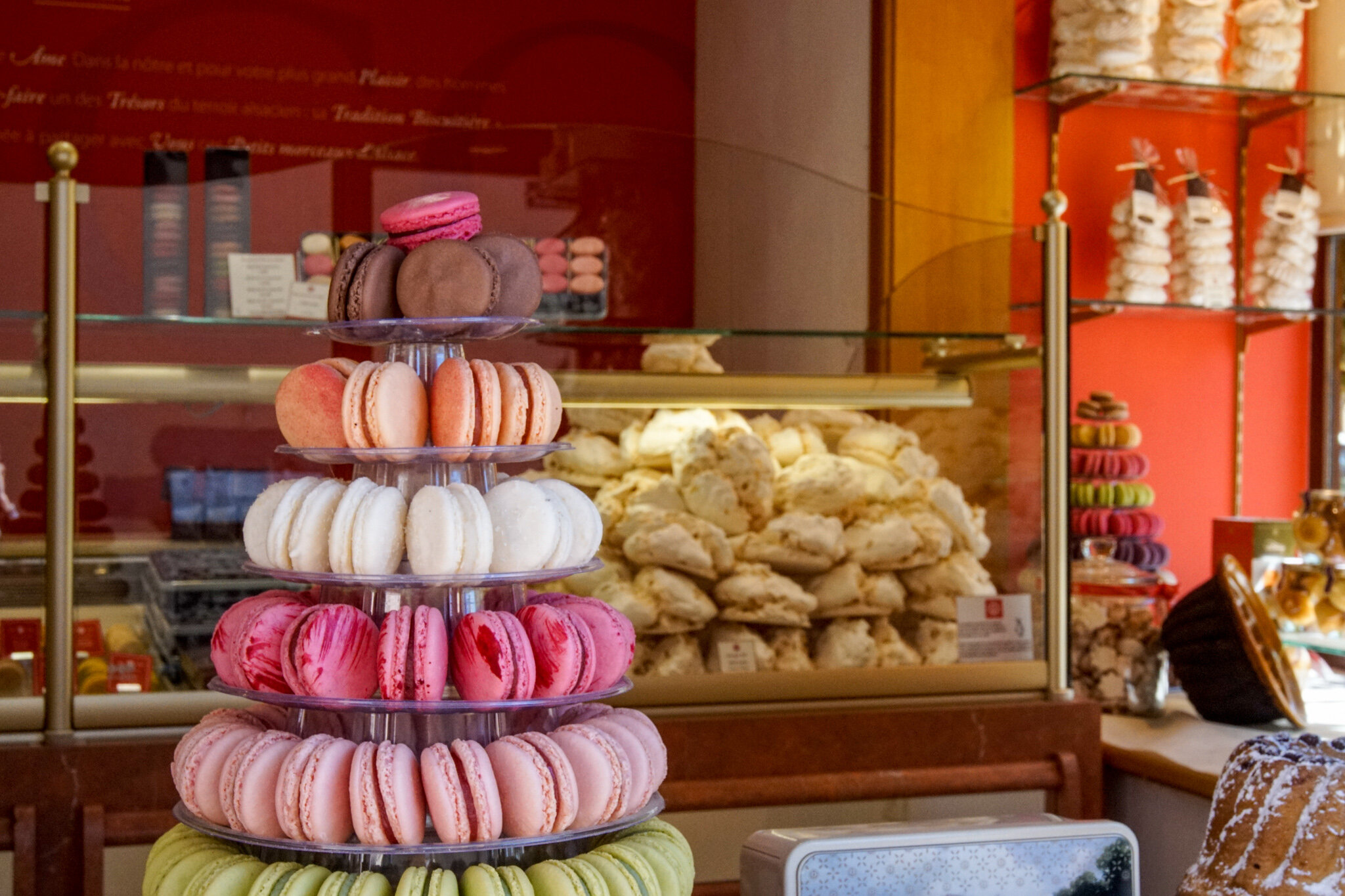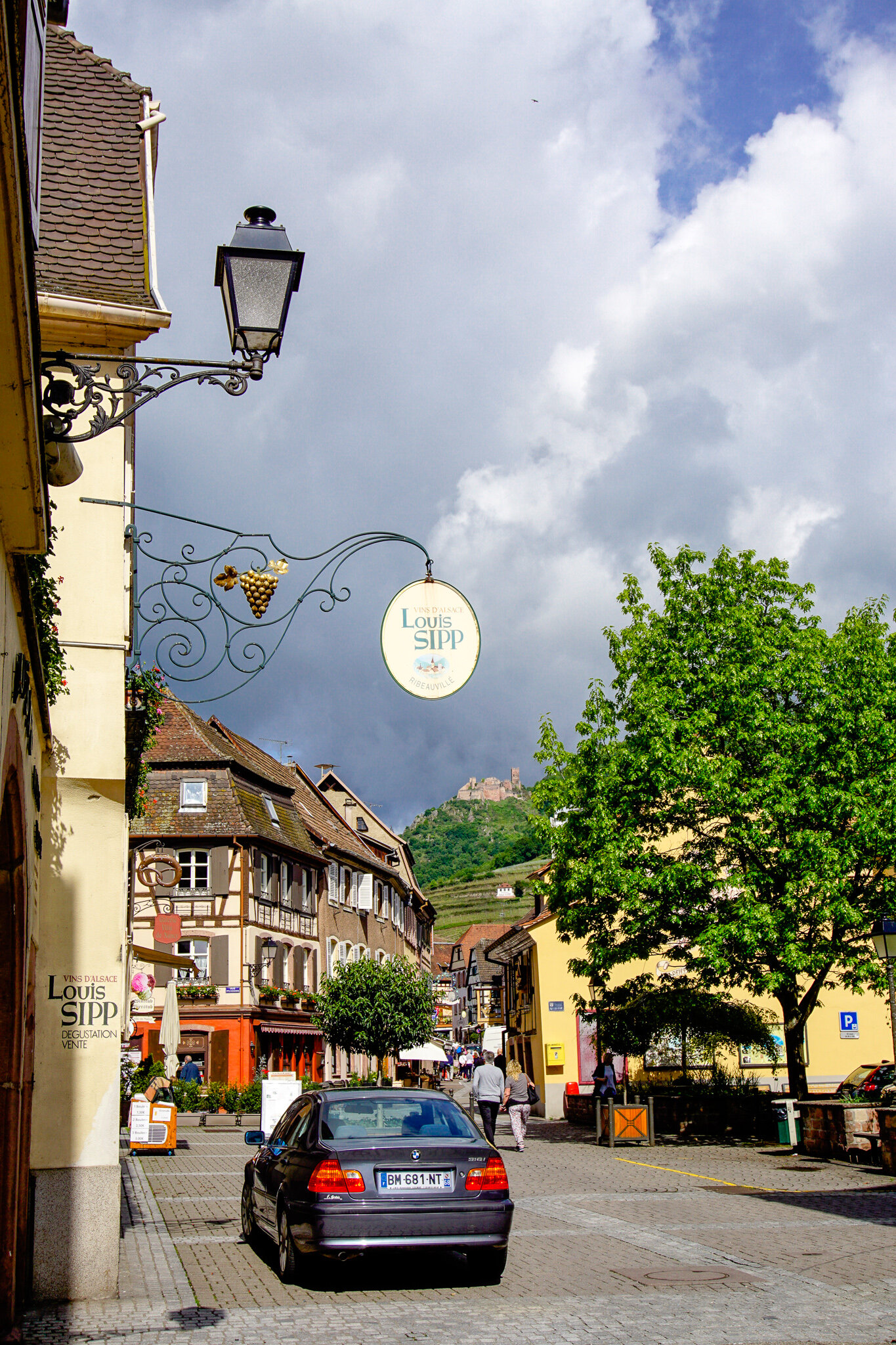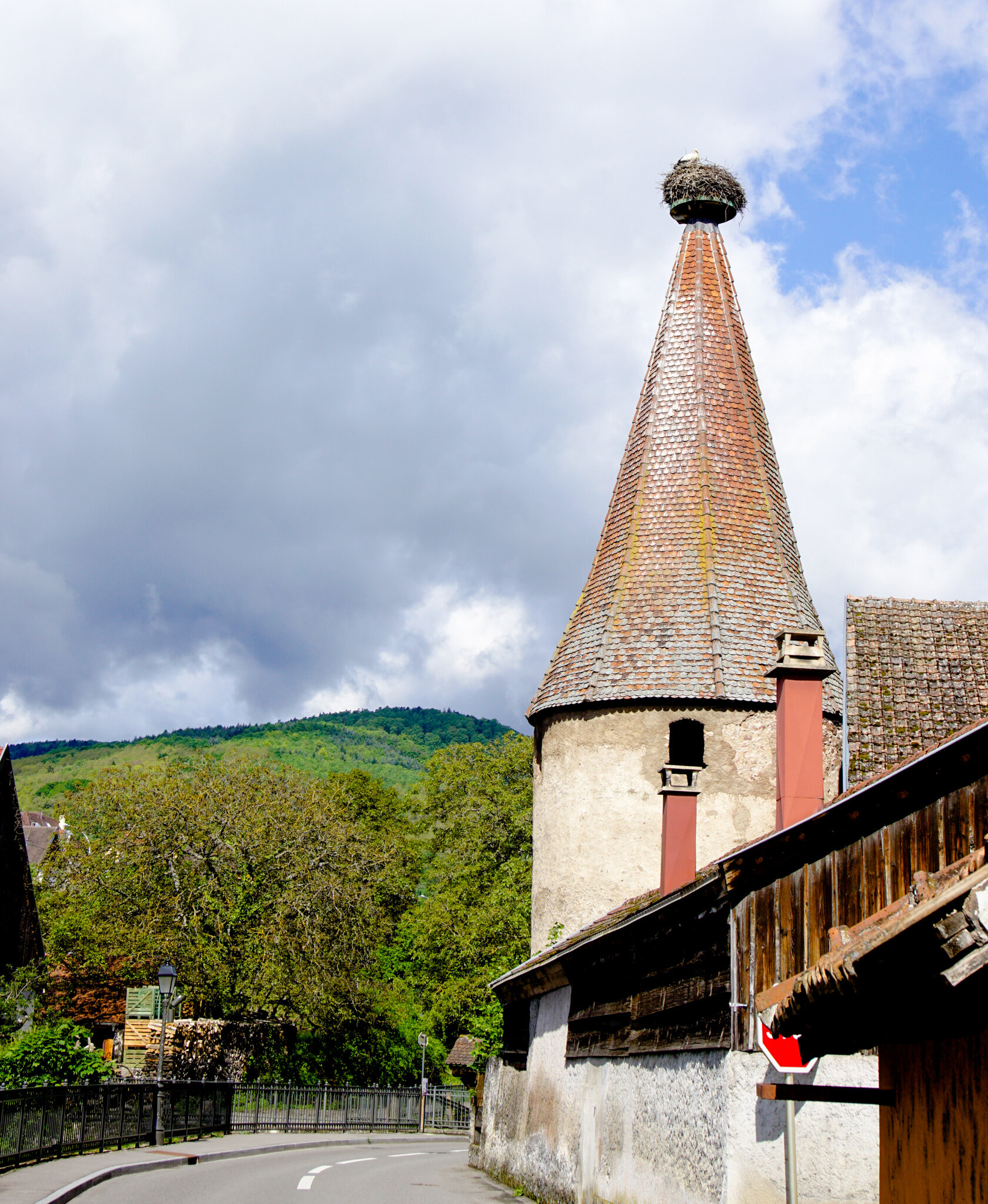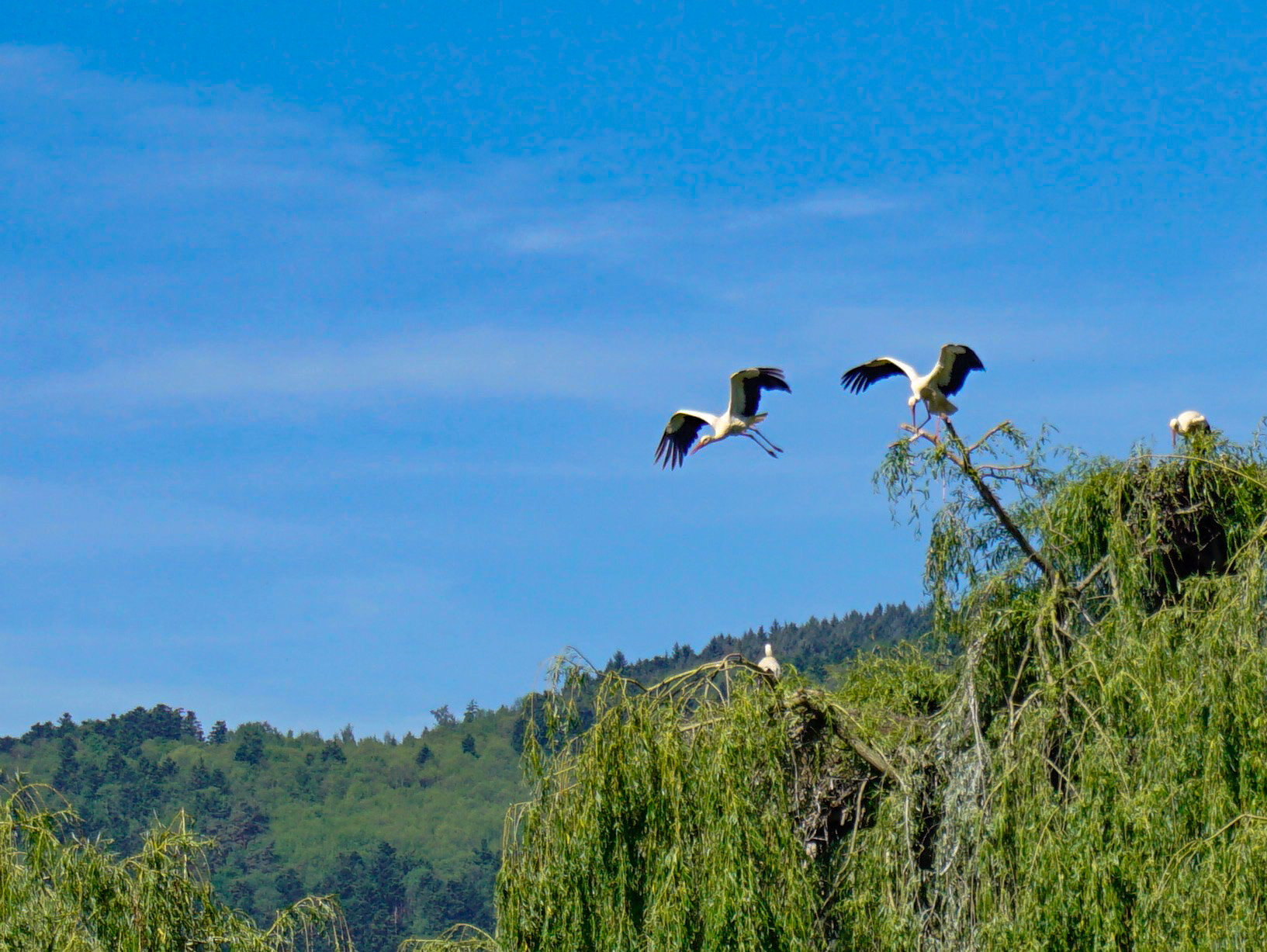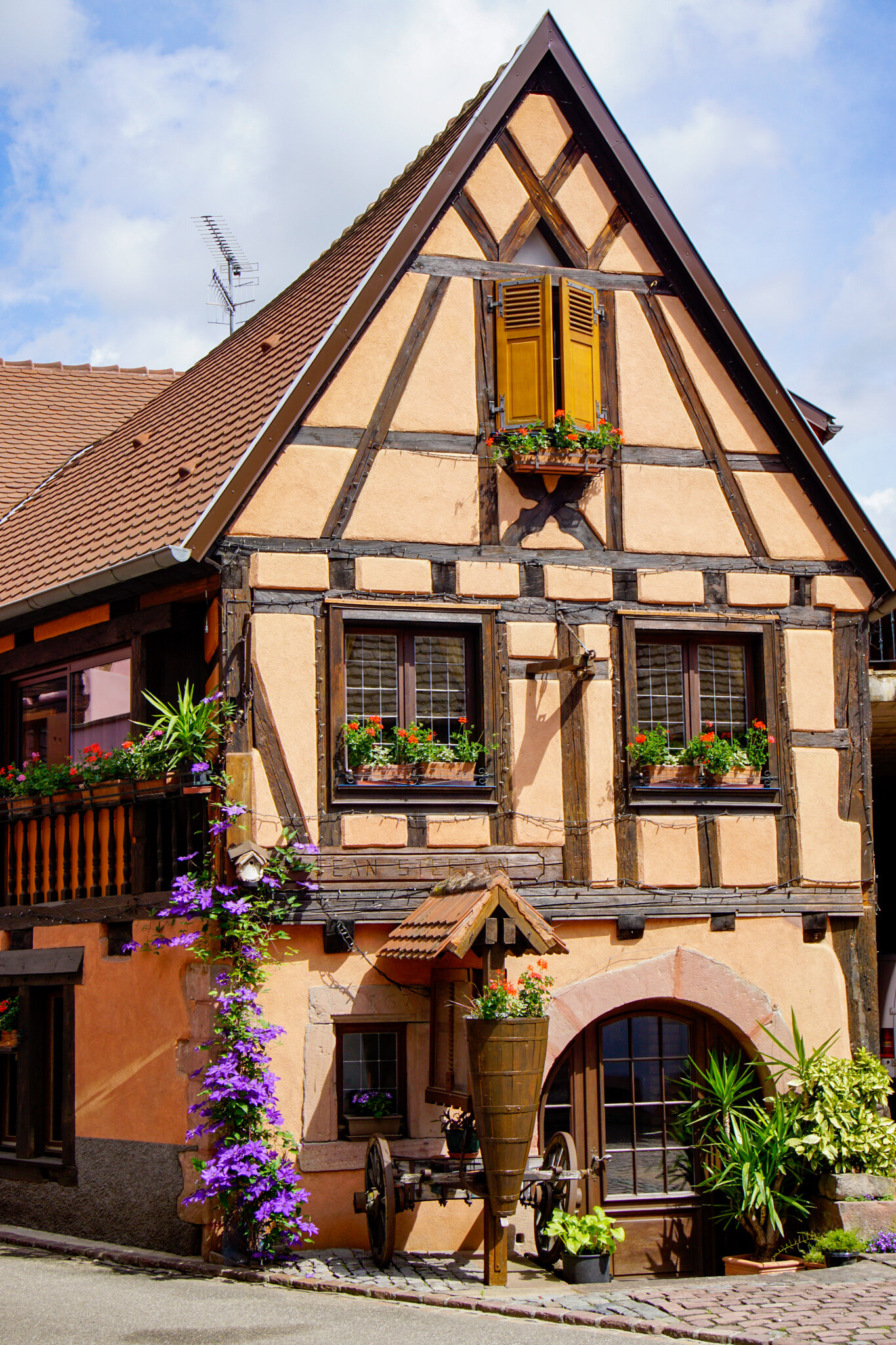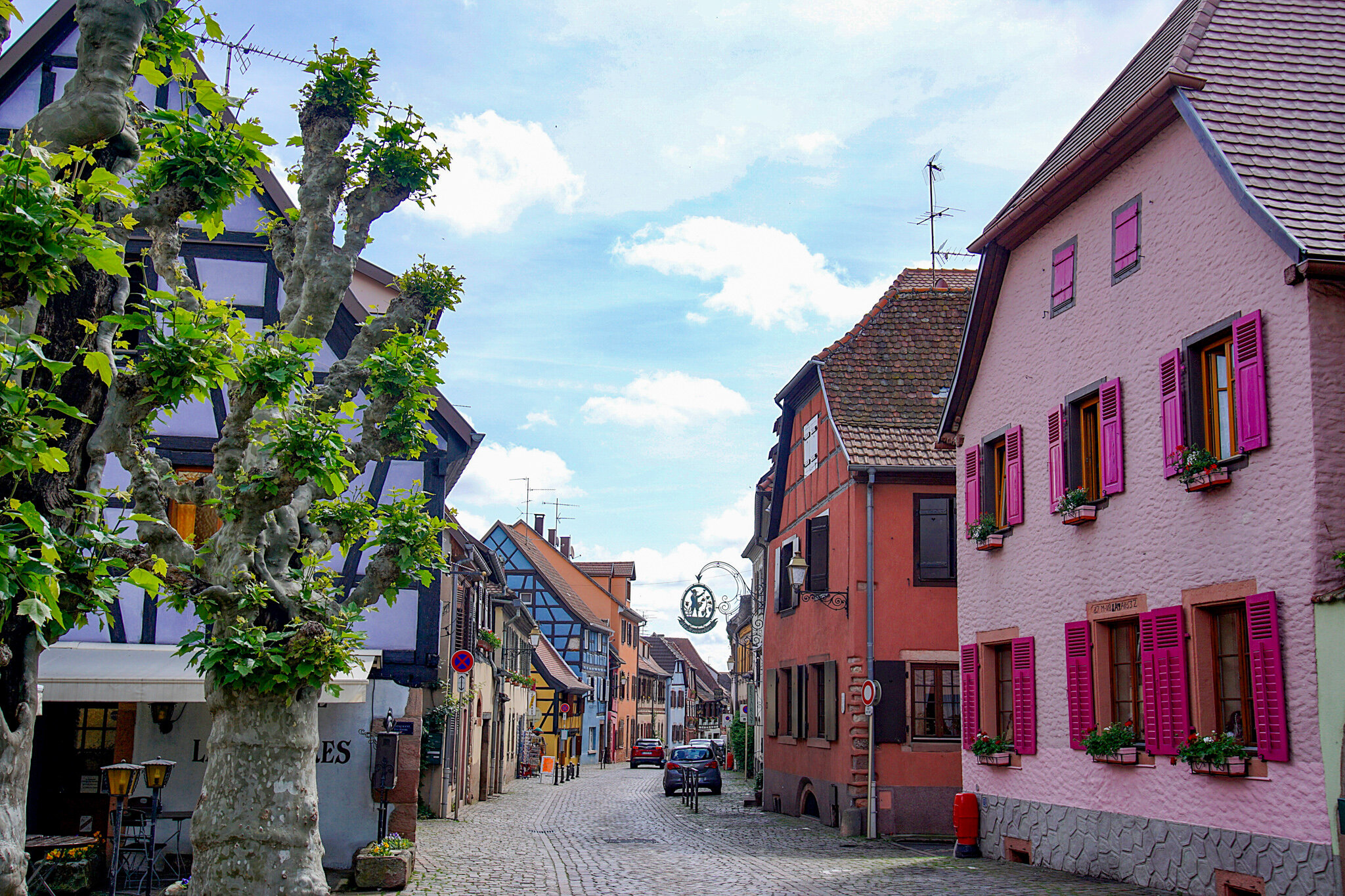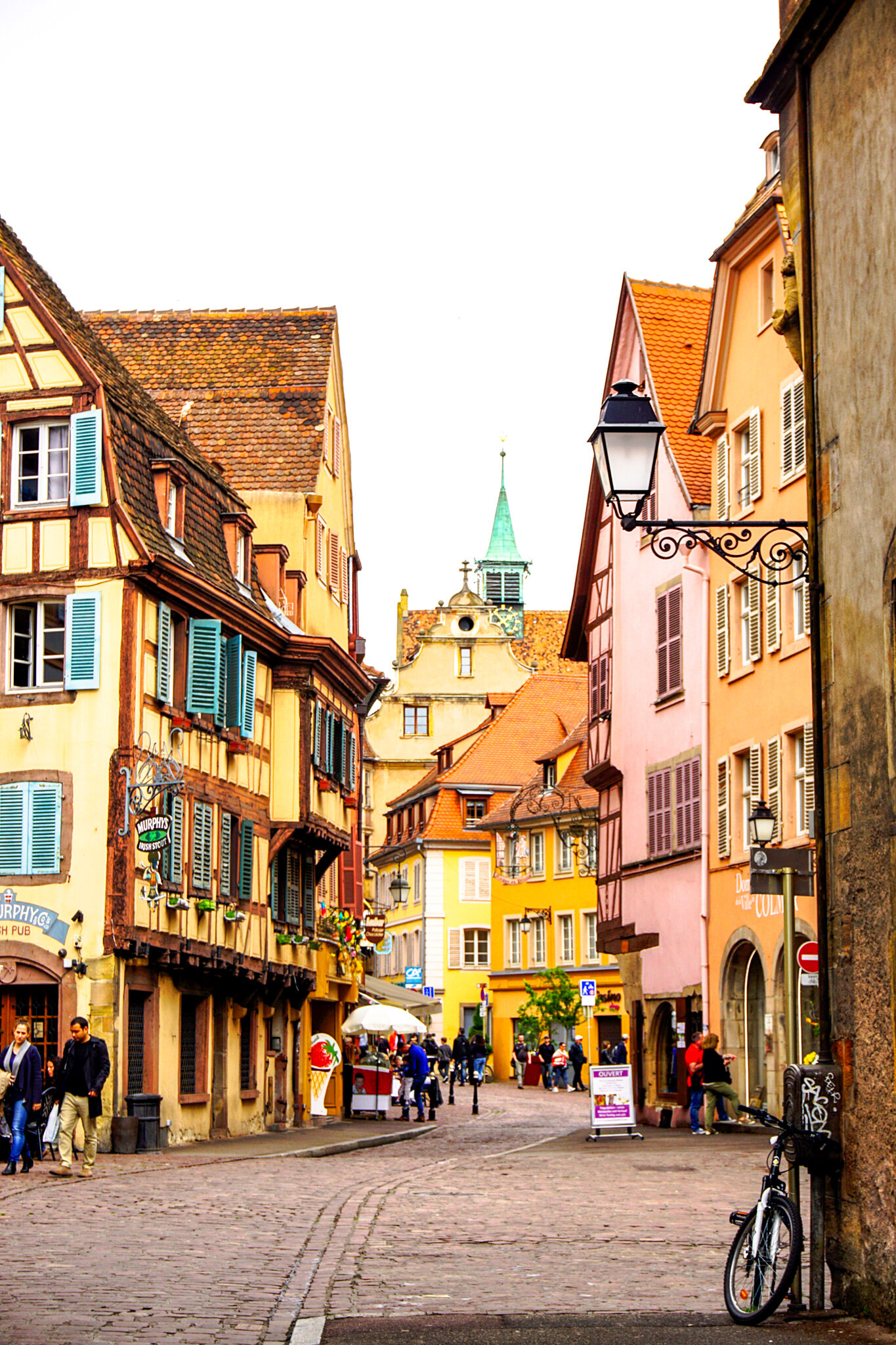Alsace: Wine Travel
Alsace is a magical place where you will find small hamlets with cobblestone pedestrian-only streets. The buildings range in colors from vibrant to pastel, all frozen in medieval times. There is an abundance of churches with spires, and unique clock towers that fill every little town. Look to the sky, and you'll discover huge nests in treetops or rooftops with storks that will amaze as they fly overhead.
This wine region in France borders Germany, and the food, language, and architecture reflect the tug-of-war over ownership. This little area has gone back and forth between the two countries for centuries.
As for wine tasting, it is a really approachable region with wineries located in or surrounding the quaint villages. Vineyards can easily be explored on foot, bike, or even horse if you're looking to work off your wine. By car, the La Route des Vins d’Alsace (The Alsace Wine Route) is clearly marked, and you can book a local to do the driving for you. Whatever your approach, you will be able to check out some of the famous Grand Cru vineyards first hand.
THE REGION:
If you have been to Napa Valley, you've had a taste of the geography. The compact, narrow vineyard region is about as wide, but doubles in length stretching 110 miles and contains five different wine-producing areas. It is sheltered by the Vosges mountains blocking the rain and providing plenty of sunshine with temperate weather conditions.
Similarly to Napa, from a wine tasting perspective, you can drop into some wineries and co-ops for a sampling. There are over 900 wineries that open their doors to tastings. For the best experiences, it is a good idea to make an appointment well in advance.
The terroir plays a key role in winemaking here; the soil, sun exposure, and slope of the vineyards are all considered and distinguished with 51 grand cru plots. There are as many as 800 different soil combinations of granite, slate, sand, chalk, and clay. Locals claim this is the most geologically complex region in France.
THE WINES:
The region is well renowned for white wines made to age, and their aromatic bouquets will bring your senses to life. Alsace whites are about the fruit rather then the oak. You will fall in love with Rieslings that are dry, not sweet.
Although nearly all the wines you find here are white, 90% of the region’s total production, there is a growing number of wineries making Pinot Noir. This is the exception for the use of oak, and with warmer seasons, Pinot is becoming a serious contender.
Another one to be sure to try is Crémant d'Alsace. This is a sparkling wine made in the traditional Champagne method and presents fantastic value. For a Rosé style it is required to be 100% Pinot Noir, but most Crémant d’Alsace is made from crisp Pinot Blanc, even though other white grapes and and Pinot Noir are allowed. Production rules insist on hand harvesting, gentle pressing, bottle fermentation and a minimum of nine months aging on lees. The Alsace laws do not end there, the parcels of vines destined for Crémant must be identified in March, so vines are tended for this sole purpose.
THE GRAPES:
Vineyards are typically planted with what is referred to as the four "noble" grapes. Generally, it is only these four grapes that can be grown in the Grand Crus vineyards;
Riesling (the most widely planted) - elegant, subtle, and fresh.
Pinot Gris - velvety and well-rounded. Perfect for flavorful dishes.
Gewurztraminer - aromatic, lively, and exotic.
Muscat - fragrant, fruity, crisp. Perfect for an aperitif.
Also of significance you’ll find;
Pinot Blanc - light and supple. It is widely planted and used to make the sparkling Crémant d'Alsace.
Sylvaner - a touch of fruit, light, and refreshing. Pairs well with seafood.
TO VISIT:
Most wineries are family-run and have been making wine for generations creating an innate knowledge of the land. You will find them focused on the growing process with a preponderance of organic and biodynamic agriculture. Many still continue handpicking their grapes even though it could easily be mechanized. If oak is used at all, it is typically 100-year-old wooden casks used for aging to maintain the authentic taste of the grape and its unique soil characteristics. There is a focus on controlling the natural acidity of the wine while ensuring the continued balance and complexity through the aging process.
Domaine Josmeyer was high on my tasting list with Isabelle Meyer, the 5th generation winemaker, using biodynamic practices. Utilizing these practices, she denotes the moon and the zodiac sign on the wine casks to reflect the major stages for the grapes within. The winery was first started in 1854 by Aloyse Meyer Josmeyer. From the beginning, Josmeyer has been identified with the vineyards of Brand and Hengst, now among Alsace's top Grands Crus. The wines share the same characteristics as many wines from Alsace, fruit-forward, but dry, and expressive of the exceptional terroir. They have an artist label program that supports local artists but also expresses the deep connection between art and wine. Their Reisling from the Hengst Grand Cru was a wonderful wine that made it’s way into our suitcase.
To discover all the women in wine in the region, check this out an association bringing together all motivated women who wish to make a commitment to help the promotion and the success of Alsace wines.
Zind-Humbrecht was a great learning and tasting experience where we tried the four noble grapes from four of their different Grand Crus. This is an appointment only, private tasting experience. The family has been making wine since 1620, making the Humbrecht family the archetype of Alsatian vineyards. The vineyards were brought together by the merger of the Humbrecht family and Zind family holdings. As a result, they are scattered all over the region, and on all types of terroir. Their wines have an overriding sense of terroir and seek to bring out the vineyard's clear and unmistakable characteristics. Some standouts were the Riesling from Clos-Saint-Urban Cru with volcanic soils and the Pinot Gris from Rotenberg vineyards. Their Pinot Gris Rotenberg and Riesling Brand Grand Cru came home in our suitcase.
One of our favorite winery visits was to Domaine Marcel Deiss. We found his experimental blends to be extremely impressive, going against the Alsatian tradition of single varieties. Their focus is on blends of different grapes to bring a specific aspect of the terroir. In their tasting, they'll have you guessing which grape variety dominates, but often everyone turned out to be wrong. We departed with some words of wisdom to carry with us; "it's not the instrument, it's the melody" and "it's not the process, it's the place." We brought home the three wines pictured; Engelgarten, Langenberg, and the Grasberg.
I don't think a trip to this region would be complete without a stop at Trimbach. The winegrowing history here dates back to the early 1600s and has seen 13 different generations of winemakers. They acquired real international acclaim in 1898 when Frédéric Emile Trimbach received the highest distinction at the International wine fair in Brussels. The estate is just outside of Ribeauville, with its two turrets overlooking the surrounding vines. You are welcomed with a sign that states, "say no to oak, help put the fruit back in wine." This was where we honestly tasted the complexity and differences in the aging of white wines; tasting their Riesling from the Clos Sainte Hune vineyard starting with 2011 and covering 2009, 2008, and 2007. The Clos Sainte Hune vineyard is the crown jewel of the estate, in the heart of Grand Cru Rosacker in Hunawihr, and definitely one every Riesling lover should taste. Finesse and elegance highlighted these wines where minerality is the dominating sensation. In essence, it was a remarkable experience, to say the least! We carried away their 2007 Cuvée Frédéric Emile Riesling, which had 5 years of bottle aging.
ALONG THE ROAD TO WINE:
There are so many little towns that are worthy of a stop and stroll when exploring this region. Hopefully, my photos will convey the essence of Alsace.
Riquewihr: This was one of the most photogenic villages with its fountains and multi-colored timbered buildings. You'll find the tasting room for Hugel in the middle of the main pedestrian-only street. The winery and tasting room have been located in the same spot for the last 370 years! Visitors can always drop in and taste, but if you want a tour, you must call well in advance for an appointment. Before you leave the walled city, be sure to stop in one of the local stores for some macaroons.
Ribeauvillé: Near the town of Riquewihr, this is another picture-worthy stop. As you walk through the enchanting streets, you can see glimpses of steep vineyards, and in the distance, catch a glimpse of the castle on the hill. You'll find Louis Sipp winery located in the town and Trimbach and Marcel Diess just outside.
In between the two villages is where you will site a large population of white storks housed in the trees. The stork has long been considered an emblem of the region, and thanks to preservation organizations, there are now roughly 600 mating pairs. It is a fantastic sight to see them in flight, but luckily not above my house because the legend says then a baby is imminent.
Bergheim: You enter the walled city through an arched clock tour, and you are immediately taken in by the brightly colored buildings and unique trees lining the street. Stroll further afield to uncover the gothic church and the witch's museum. Housed here are the records of the lives of the women who were tortured, judged, and burnt at the stake in for alleged acts of witchery. It was all probably due to their knowledge of the herbs grown here and their medicinal capabilities.
TO STAY:
We used the town of Colmar as our home base, rated one of the most beautiful in all of France and for a good reason. You can stroll along the river, beautifully lined with flowers, and settle into one of the many picture-perfect squares for a glass of wine. It's at the heart of the Alsace wine route, making it an ideal place to explore the region.
We stayed at a lovely apartment in the heart of the shopping area and above a cafe. It was lovely to pop in for an expresso and a chocolate croissant in the morning. The area had plenty of restaurants and only a five minute walk to what is referred to as La Petite Venise.
TO EAT:
Typical dishes lean toward the German influence, Alsatian braised sauerkraut with sausages, and pretzel stands can be found throughout the towns.
Tarte Flambée, a flatbread topped with creamy cheese, bacon, and onion, is so scrumptious, but I don't even want to know the calorie count.
Côté Vigne Restaurant, in Kayserberg, was an excellent locals suggestion, and an ideal location for our afternoon appointment at Zind-Humbrecht. You can eat outside, basically in the middle of the little town, surrounded by flowers and a fountain.
This is an upscale establishment with delicious French contemporary cuisine, I would highly recommend. You can dine on the patio and be surrounded by vineyards.
There are over 25 Michelin-starred restaurants in Alsace, so if you want an incredible dining experience, this is another reason why this region is for you. Chambard is one of those, with Chef Olivier Nasti working wonders. It's also a short walk to Domaine Weinbach on the edge of Kaysersberg. If you want more of a workout, head up to the castle, Château de Kaysersberg.



